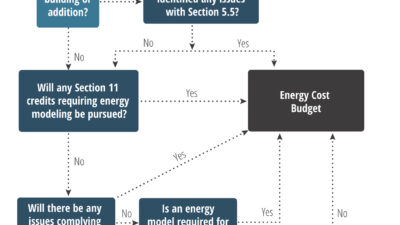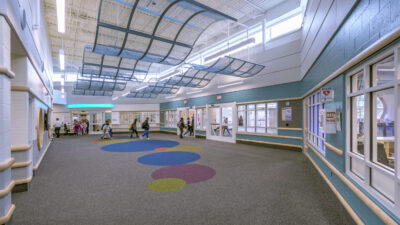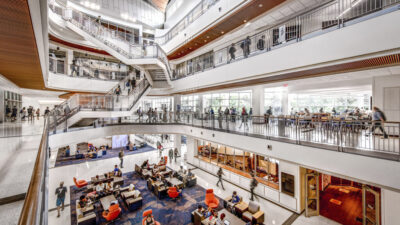Many engineering companies and their clients are taking a second look at emergency lighting systems because of concerns about code combined with energy efficiency, and U.S. Green Building Council LEED demands.
Many engineering companies and their clients are taking a second look at emergency lighting systems because of concerns about code combined with energy efficiency, and U.S. Green Building Council LEED demands. Upon discovering that the systems they specify do not meet USGBC requirements, many are taking an unconventional approach by using a UPS system, an economical solution to support and enhance emergency lighting systems.
Various codes describe the exit path requirements for safe exiting of buildings. Chapter 10 of the International Building Code (IBC) describes the requirements for the means of egress as being a “continuous and unobstructed path of vertical and horizontal egress travel from any occupied portion of a building to a public way.”
It defines this path as consisting of three parts: exit access, exit, and exit discharge. The exit access is defined as an area leading from an occupied area through an area that is separated by fire-rated construction, thus providing a protected path leading to the exterior doors at ground level. The exterior door is referred to as the exit. The exit discharge is defined as the area from the exit to a public right-of-way.
The IBC provides further detail by describing the height and width of the means of egress including a restriction for protruding objects of up to 4 in. An occupant load table lists specific types of areas and the corresponding maximum occupants allowed including mezzanine levels, fixed seating, and outdoor areas. The code additionally specifies that yards, courts, and similar outdoor areas accessible to and usable by the building occupants also have a means of egress.
Illumination for the egress path, including the exit discharge, is required by the IBC to be a minimum of 1 foot-candle (11 lux) at the walking surface. There are, however, a few exceptions, which include dwelling units and sleeping units within groups R-1, R-2, and R-3.
R-1 is defined as residential occupancies having sleeping areas, such as hotels or motels; R-2 is considered to be residential occupancies including apartments and dormitories; R-3 occupancies include duplexes, child care for fewer than five people, or congregate living with 16 or fewer people. Auditoriums, theaters, and concert or opera halls can have reduced lighting during performances, but not less than a minimum of 0.2 foot-candle. All lighting must be restored to standard regulations upon activation of the fire alarm system.
For emergency lighting, the IBC requires initial illumination to be at least an average of 1 foot-candle and a minimum of 0.1 foot-candle. It is permitted to decline to an average of 0.6 foot-candle and a minimum of 0.06 foot-candle at the end of the 90-min duration for which the emergency power system is required to sustain the building.
It is important to realize that the code establishes the minimum requirements that apply to small single-story offices, as well as churches or school gyms that can have a much higher occupancy.
Although the IBC seems to be the most commonly cited reference for emergency lighting requirements, it is good practice to check with state and local jurisdictions before beginning any project to ensure that local requirements are met. For example, in previous codes, California based its requirements on the Uniform Building Code and listed a minimum of 1 foot-candle rather than an average of 1 foot-candle for emergency egress lighting.
While there are a number of options that accommodate these requirements, a UPS system holds key advantages over its competitors in certain situations.
Advantages of a UPS system
Before moving forward with a UPS solution for emergency lighting, it’s imperative to understand the most conducive environments for a successful deployment. Some characteristics include:
• No defined egress path: Facilities that do not have a defined egress path, such as open offices with moveable partitions, large manufacturing spaces or warehouses, and outdoor courtyards, are best suited for a UPS system. A UPS system provides more power to the emergency lighting, resulting in higher lumen output for a longer period of time.
Standard battery packs for T-8 lamps provide a level of reduced lighting at around 300 lumens. (In certain cases, higher output can be provided at an increased cost.) Lumen output during the code-required 90 min may not be a linear reduction to 60%. For some products, it declines during the first 10 to 15 min to about 70% and then continues to drop to the minimum code level. UPS systems provide full output for the 90-min duration and may be an advantage for larger areas and some occupancy types.
• High ceilings: Typically, facilities that do not have any defined egress paths may also have high ceilings. Emergency lighting units and fluorescent battery packs are often not ideal for these applications. As shown by the system installed at the Hunter Douglas manufacturing facility (See sidebar “Lowering costs”), required routing testing and maintenance is more efficient with a single floor-mounted UPS system than a series of fluorescent battery packs at the 30-ft ceiling height.
• Cold climate: For outdoor lighting or large food storage coolers and freezers, temperature can become a problem for battery systems because ideal battery temperature is 78 F. While some emergency lighting units and fluorescent battery packs are now rated for 0 F where small resistive heaters have been included, a UPS system may still provide the best solution. The UPS system can be located inside the facility or in a separate, temperature-controlled area. Lamp type is not restricted, and full lumen output is maintained.
• Testing requirements: NPFA 101, Life Safety Code, states that functional tests of emergency lighting equipment are required at 30-day intervals for not less than 30 sec, and annually for not less than 90 min for a battery-powered system. Written records of visual inspections and tests are to be kept by the owner for inspection by the authority having jurisdiction (AHJ).
Where fluorescent battery packs are used or emergency lighting units are installed, the individual units may need to be individually tested with the test button, or the circuits that feed them may need to be tripped so that the units can be checked. This can take significant time and record keeping in a larger complex. By using a UPS system, the lights are directly powered and lamp replacement will fall under routine maintenance.
• Significant exterior lighting needs: Facilities that require a significant amount of exterior emergency lighting, such as large apartment complexes, senior living centers, school buildings, and parking garages, are another application ideally suited for a UPS system. For the number of lights needed, it is not ideal to use individual fluorescent battery packs. Some building operators also have avoided using generators because of the added hassles of environmental regulations, restricted hours of operation, fuel storage permits, testing, and record keeping. One jurisdiction in Nevada will not accept generators as the primary emergency lighting source as they had a critical failure during a fire. By using a UPS system, the exterior emergency lighting is connected and controlled from a single location. This results in significant savings in regular performance of testing and maintenance. The UPS system also can be sized to provide longer run times in critical applications as compared to individual 90-min battery packs.
Specifying UPS systems
Several products currently are available that can help meet emergency lighting requirements for most applications including emergency lighting units, fluorescent battery packs, and on-site generation. UPS systems are one of the more economical solutions to emergency lighting requirements and have been growing in popularity.
Lighting UPS systems are UL 924 listed and differ from other UPS systems that typically are used in data center environments in that they provide 90 min of full lighting output at their listed capacity and have a quicker recharge time for a larger battery. They support incandescent, fluorescent, and high intensity discharge (HID) lamps—or any combination of lamp types.
UPS systems typically have a dual rating such as 10 kVA/8 kW. Electronic ballasts typically have a power factor of 95% to 99%. HID fixtures tend to have a power factor of 90%, while incandescent lighting has a power factor of unity or 100%.
It is important to consider the kiloWatt rating of the UPS during the design of the project because lighting can operate at close to unity power factor. (Note: Be sure to check with the manufacturer to determine if the UPS unit’s rating is for a continuous lighting load.)
A UPS system is an economical solution to support emergency lighting in high-bay manufacturing, churches, restaurants, larger apartments, senior assisted living projects, offices, and parking garages. It has become one of the first preferences for contractors as an economic way to meet costs and satisfy or even exceed code requirements. A quality UPS system for certain projects can reduce the cost of installation and eliminate the issues associated with solutions that rely on battery packs. Although more advantageous in some situations than others, a UPS system can be considered the best emergency lighting solution at a feasible cost.
| Author Information |
| Hines is a senior electrical engineer with Rex Moore Electrical Contractors and Engineers, Sacramento, Calif. He has designed emergency lighting systems for various projects such as the Hunter Douglas manufacturing facility and the Progressive Baptist Church. Both were recognized by Pacific Gas & Electric Co., the local utility provider, for its Savings by Design program and received energy incentive awards. |
Lowering costs
Hunter Douglas, a window treatment manufacturer, installed a Liebert NX UPS system from Emerson Network Power in its West Sacramento, Calif., manufacturing facility. The facility featured a 30-ft ceiling and used Lithonia I-beam fixtures with T-5 lamps to provide high-quality, energy-efficient lighting. The emergency lighting was designed for a minimum of 1 foot-candle to ensure safe exiting. An analysis conducted at the start of the project showed that using fluorescent battery packs would have been more expensive to install, maintain, and test than a floor-mounted UPS system.
Exceeding requirements
Progressive Baptist Church in Stockton, Calif., installed emergency lighting supported by Emerson Network Power’s Liebert NX UPS system. The general illumination in the facility was provided by fluorescent down lights with two 42 W compact fluorescent lamps and dimming ballasts. A lighting automatic transfer switch was used to switch between a theatrical dimmer and the UPS system upon power failure. This exceeded the present code requirement for emergency lighting, which was important because of the higher occupancy of the facility during services. In comparison with fluorescent battery packs, installation cost was in favor of the UPS system. Also, because of the need for dimming control, additional wiring would have been required if fluorescent battery packs had been used.



